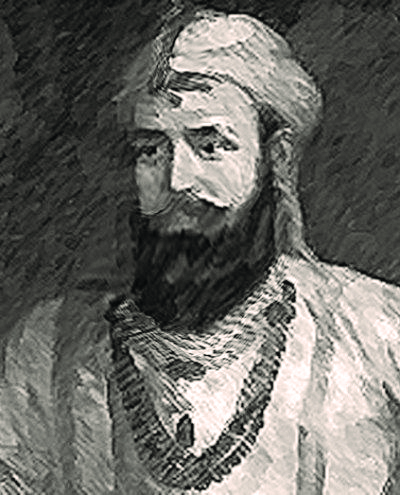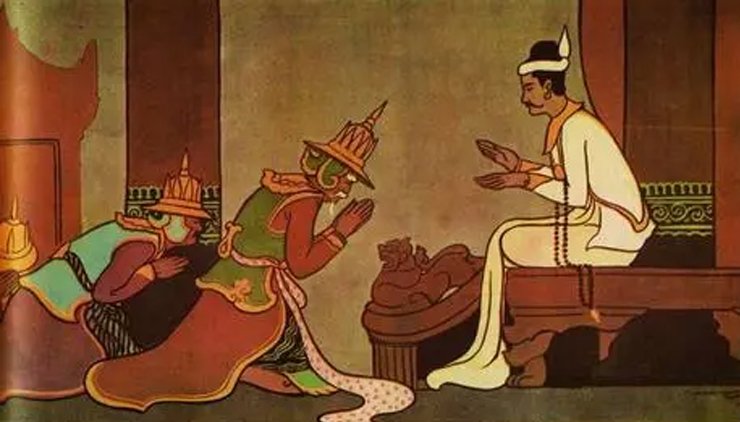
Magadha King Bimbisar (543 BC-491 BC) was a great friend of Gautam Buddha. He belonged to the Haryanaka dynasty of the ancient kingdom and ruled eastern India, including the modern-day Bihar and Bengal. His capital was today’s town of Rajgir. He is considered to have laid the foundation of the Mauryan empire. One of Bimbisar’s major achievements was the annexation of the kingdom of Anga, which was a flourishing kingdom in eastern India and one of the 16 mahajanapadas. It was situated to the east of its neighbour and rival, Magadha, and was separated from it by the river Champa. Bimbisar is known for his justice and generosity during his rule. He built the city of Rajgriha, famous in Buddhist writings. He was assassinated by his son Ajatshatru for the throne. Bimbisar was 15 when he became the king and 52 when he was murdered.
In Buddhist sources, Bimbisar is recorded as having been a close friend of King Suddhodana, father of Gautam Buddha. He and his son became patrons of Buddhism. He is also said to have been a friend of Mahavira, or Jina, the great teacher of the Jain tradition.
Peaceful ties with peers
Although Bimbisar expanded his territory, he enjoyed peaceful relations with his peers. As a just and generous king, he provided royal patronage to the Buddha without which he (Siddharth) might have been killed (there were several attempts on his life) or Buddhism would not have spread as successfully as it did. Some of those who opposed the Buddha said that he tricked people into following him. Opposition tended to stem from his rejection of some commonly accepted religious and philosophical dogmas and because there was no place for privilege of birth or of wealth in his system.
There is little doubt that Bimbisar played a key role in spreading the gift of Buddha’s teaching in the world. Later, Ashoka the Great would take royal patronage of Buddhism a step further by renouncing military expansion. Bimbisar may have laid two foundations on which Ashoka could build — a territory that provided the basis of the larger Mauryan empire that Ashoka inherited, and the survival of the faith that Ashoka embraced like Bimbisar, while his grandfather Chandragupta Maurya had embraced Jainism.
Bimbisar’s annexation of territories in Bengal is said to have laid the foundation of the later Mauryan empire under Chandragupta Maurya. He acquired Anga and placed it under the viceroyalty of his son Ajatshatru, with its capital at Champa. He appears in some relics at Borobudur, Java dated eighth century CE, which also depict the Buddha and other contemporaries.

Contemporary of the Buddha
There are many accounts of Bimbisar in the Buddhist Jatakas (one of the three scriptures of the Pali canon), since he was a contemporary of Gautam Buddha. Gautam is said to have arrived at the gates of Bimbisar’s city Rajgriha before having attained enlightenment and begged for food from door to door. No one called him ‘prince’ but as soon as Bimbisar saw him, he recognised him as Suddhodan’s son, a prince.
Assuming that the prince must have quarrelled with his father, the king invited Siddharth to stay and to accept half of his kingdom. Siddharth replied that he had to continue his search for a way to stop old age, suffering and death because he loved his wife, his son, his parents, King Bimbisar and everyone else. He promised that he would return after attaining his goal.
Gautam Buddha did return after his enlightenment, this time with a large number of disciples. Hearing of this, Bimbisar, about 30 years old at that, went beyond the city limits to greet the Buddha, a famous teacher by that time.
Some people were uncertain which of the visiting monks was actually the Buddha, mistaking one of his disciples for him. That disciple immediately pointed to the real Buddha, who started to teach. King Bimbisar, so the story goes, attained then and there the first stage of awakening and became the Buddha’s first royal patron.
Bimbisar fed the Buddha and his disciples and gave them Veluvana, the pleasure garden of the king, to stay as long as they liked. Bimbisar, for the rest of his life, adopted the eight precepts of the Uposatha for six days each month. The first Buddhist convocation convened after the death of the Buddha was held in the capital city of Bimbisar. The Pali or Buddhist canon was determined at this convocation.
First woman disciple
When the Buddha returned after his enlightenment along with a large number of disciples, King Bimbisar received the Buddha, a famous teacher by that time, at the entrance to the city
Bimbisar’s third wife Khema became the Buddha’s first woman follower. Taking her precepts as a bhikkhuni (nun), she was described by the Buddha as a perfect disciple. On one occasion, Khema’s answers to the questions posed by a king were exactly the same as those the Buddha had answered to the questions, although she was unaware of his reply. She was known as ‘Khema of great wisdom’.
Bimbisar used marriage alliances to strengthen his strategic position. His first wife was the sister of Prasenajit, king of Kosala. The bride brought him Kashi, which was then a mere village, as a dowry. This marriage resolved the disputes between Magadha and Kosala and gave him a free hand in dealing with the other states. Bimbisar’s second wife Chellana was a Lachchhavi princess from Vaishali and a relative of Mahavir’s mother. His third wife was the daughter of the chief of the Madra clan of Punjab. Bimbisar is said to have enjoyed friendly relations with all his contemporary peers.
– The writer is a senior journalist and media consultant. The views expressed are of the writer and do not necessarily reflect the views of Raksha Anirveda








